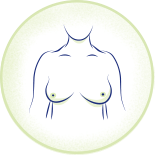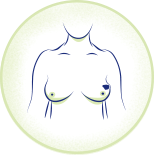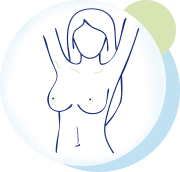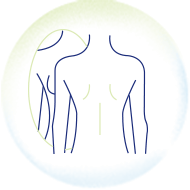Breast Cancer is the Most Diagnosed Cancer Among Women in Hong Kong1
In recent years, breast cancer has become the most common cancer affecting females in Hong Kong, showing no sign of abating, with 1 in every 14 women bearing the lifetime risk of developing breast cancer. Although nearly half of the cases diagnosed were among women aged >40 years, those at a younger age are not immune from breast cancer. In fact, in Hong Kong the youngest case reported was below 25 years old and the median age of breast cancer diagnoses is 58 years old, compared with the age of 62 in the United States, 60 in Australia.
Early Detection is of Utmost Importance2-5
The aim of breast self-examination is to detect breast cancer before symptoms develop. Early detection with timely treatment may help achieve better outcomes and increase the overall survival rate. Symptoms of early-stage breast cancer could be difficult to detect. As such, the Centre for Health Protection advised that women should be “breast aware” – to be familiar with the normal look and feel of their breasts and be alert of any abnormal changes
Symptoms of Breast Cancer2,3
If you find lump(s) in your breast when performing a self-examination, please do not panic as most lumps or changes may not necessarily be associated with breast cancer. However, in case you noticed abnormal changes to your breasts, please seek for a doctor’s advice to determine if further check-up is required. Please be reminded that delayed diagnosis or treatment could impact the survival rate of breast cancer.
-

Changes in shape and size of
the breasts -

Lumps or thickening
of the skin -

Nipple retraction
or dents in the skin -

Reddish or bloody nipple discharge
-

Lumps or changes in shape or thickening of the nipples
-

Swelling of the
axillary lymph nodes
The Self-Examination Guide3-7
Women aged >20 years should undergo a breast self-examination monthly. Premenopausal women should conduct the examination 7-10 days post-menstruation, while post-menopausal women should conduct the examination on the same day of each month.
The following steps of “Observe, Touch, Compare” will help you to know more about your breasts:
-

Observe
Look out for any changes in the breast skin, nipples, and any nipple discharge
-

Touch
Feel your breasts for any hard lumps, thickening or pain. Unusual touch on only one side of the breasts may not be associated with menstruation
-

Compare
Compare the current and previous breast size and look. Detect for any changes in both sides of your breast
It only takes a few minutes to conduct a breast self-examination, such as when you are changing clothes, taking a bath, or lying in bed.
-

Changing clothes
Face the mirror and take the following postures to observe any aforementioned changes in your breasts and any signs of discharge:- Hands on your waist with straightened shoulders
- Raise both arms above your head
-

Lying in bed
- When lying down, prop up one shoulder with a pillow
- Raise the arm of the same side
- Use the other hand to check for any lumps or abnormalities of the breast
- Feel your breast with your finger in a small circular motion while keeping your fingertips aligned. The more pressure you apply, the deeper the tissue you are examining.
- Systematically evaluate both sides of your breast, from the neck to the upper abdomen and the armpits to the cleavage to ensure you have covered all the spots
-

Taking a Bath
You may choose to stand or sit when bathing, then follow the above finger pressure approach to perform the breast self-examination
Incorporate breast self-examination into your daily routine as it is simple and convenient to perform. It is also essential for early detection of breast cancer. Take up the habit of breast self-examination and be familiar with the normal look and feel of your breasts, so that you will be able to detect any abnormalities and consult your doctor at once.
When to Proceed to Further Examinations3,8
Self-examination is of utmost importance to maintaining breast health, however, screening and check-ups by doctors are also indispensable. The following additional examinations will be arranged for you (either taking one or multiple items) if deemed necessary by your doctor:
-
1
Mammography Screening

Detect early changes, identify cancerous growth before lumps are formed
-
2
Biopsy

Extract tumor tissue and determine tumor type
-
3
Ultrasound

Detect and identify location, size and characteristics of the tumour, as well as axillary lymph node swelling
-
4
Blood Tests

Detect biomarkers in the bloodstream essential for tumor growth as an indicator of cancer
-
5
Liver Ultrasound

Determine if the cancer has spread to the liver
-
6
Computed Tomography (CT) Bone Scan

Determine if tumor has spread to the bones
-
7
Hormone Receptor Tests

Identify your hormone receptor profile, which helps to tailor the most suitable treatment plan
-
8
HER2
Receptor Test
Identify if you have HER2 receptors or the gene that produces the HER2 protein which helps to determine the suitable treatment
Classification of the Risk of Breast Cancer3,8
In 2021, the Centre for Health Protection issued a list of updated recommendations on women breast cancer screening, depending on their risks of breast cancer (applicable to women aged between 44-69 years):
- LOW RISK
- MEDIUM RISK
- HIGH RISK
LOW RISK
Risk factors

- Family history of breast cancer in first-degree female relative
- Diagnosed with benign breast disease
- Has never given birth or has given birth at a late age (>35 years old)
- First menstruation at an early age (<12 years old)
- High body mass index (The standard may vary based on age and gender of the individual)
Screening options

- Consider a mammography screening every 2 years and consult your doctor for the potential benefits and disadvantages of screening
- Magnetic resonance imaging not recommended
MEDIUM RISK
Risk factors

- One first-degree female relative diagnosed with breast cancer on or before the age of 50
- Two first-degree female relatives diagnosed with breast cancer after the age of 50
Screening options

- Consider a mammography screening every 2 years and consult your doctor for the potential benefits and disadvantages of screening
- Magnetic resonance imaging not recommended
HIGH RISK
Risk factors

- Family history of breast cancer or ovarian cancer
- History of diagnosis with ductal carcinoma in situ or lobular carcinoma
- Confirmed carriers of BRCA1/2 mutation
- Received chest radiotherapy between the ages of 10 and 30 years
Screening options

- Consult your doctor and undergo an annual mammography screening before the age of 35 or 10 years prior the earliest age of diagnosis of a relative with breast cancer, whichever is earlier but not before the age of 30 years
- For women who are confirmed carriers of BRCA1/2 mutation, or had received chest radiotherapy between the ages of 10 and 30 years, consider undergoing an additional magnetic resonance imaging every year
This following information is intended for Hong Kong metastatic breast cancer patients receiving Ibrance® and residing in Hong Kong only. You are required to declare and confirm that you are diagnosed by a qualified oncologist in Hong Kong before you can access this site. The contents of this website are provided for metastatic breast cancer patients’ viewing, general information and educational purposes only. The information enclosed is for your understanding of the disease and is provided via your Healthcare Provider. The information is for patients who receive Ibrance®. It cannot replace a consultation with medical professional nor as a basis of self-diagnosis or for treatment decision. Please consult your doctor for more information. You are also required to read the “Terms of Use” and “Privacy Policy” for the use of this website. Are you a metastatic breast cancer patient receiving Ibrance® and residing in Hong Kong?
References
-
HK Breast Cancer Foundation. Local Statistics. Available at:
https://www.hkbcf.org/en/breast_cancer/main/101/. Accessed October 25, 2022. - Song QK, et al. Asian Pac J Cancer Prev, 2014; 15 (22); 10021-10025.
-
Smart Patient Hospital Authority. Available at:
https://www21.ha.org.hk/smartpatient/SPW/zh-HK/Disease-Information/Disease/?guid=bc5c075d-d161-4abc-9b1b-1b1ca15d6947. Accessed October 25, 2022. -
Cancer Fund. Understanding Breast Cancer. Available at:
https://www.cancer-fund.org/wp-content/uploads/2018/10/Breast-Cancer-July18EC.pdf.
Accessed October 25, 2022. - American Cancer Society. Available at:
https://www.cancer.org/cancer/breast-cancer/screening-tests-and-early-detection/american-cancer-society-recommendations-for-the-early-detection-of-breast-cancer.html. Accessed November 22, 2022 -
Breast Cancer Org. Breast Self-Exam. Available at:
https://www.breastcancer.org/screening-testing/breast-self-exam-bse. Accessed October 25, 2022. -
National Breast Cancer Foundation. Breast Self-Exam. Available at:
https://www.nationalbreastcancer.org/breast-self-exam. Accessed October 25, 2022. - Centre for Health Protection. Recommendations on Prevention and Screening for Breast Cancer for Health
Disclaimer
This tool is intended for informational purposes only. It is not a substitute for a discussion with healthcare professionals.
All treatment decisions are to be made at the discretion of the healthcare providers.

